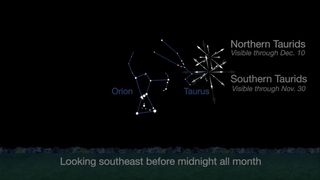2017 Taurid Meteor Shower Peaks This Weekend! What to Expect
If skies are clear this weekend, be sure to take a few moments to gaze upward. You just might be lucky and catch a glimpse of a spectacularly bright meteor from the Taurid meteor shower. While most meteor displays last about a week, the Taurids have perhaps the longest duration of overall visibility. Meteors from this particular stream begin appearing in mid-October and continue into mid-November. November 5 through 12 is traditionally the period when these slow and majestic meteors are at their best.
Unfortunately, in 2017, this display has — so far — been seriously hindered by the presence of a brilliant moon. The moon turned full Saturday (Nov. 4) with bright moonlight flooding the sky much of the night, pretty much washing out all but the brightest meteors. Thereafter, however, the moon has been setting later in the evening and slowly waning in brightness. Last quarter is on Nov. 10 and thereafter the moon will be a progressively thinning crescent.
So with each passing night, the moon has been rising about an hour later and the window of dark-sky hours (prior to moonrise) has opened a little wider. Sunday night (Nov. 12) is probably the best night to watch, as there will be about 7 hours of dark, moonless skies to look for Taurids. [Taurid Meteor Shower 2017: When, Where & How to See It]

Each evening, up until the time the moon comes above the horizon, up to about 15 meteors may be visible per hour. They are often yellowish-orange and, as meteors go, appear to move rather slowly. Their name comes from the way they seem to radiate from the constellation Taurus, the Bull, which sits low in the east a couple of hours after sundown and is almost directly overhead by around 1:30 a.m. — which is also about the time the moon will rise late Sunday night/early Monday morning.
Meteors, popularly referred to as "shooting stars," are generated when debris enters and burns up in Earth's atmosphere. Regarding the Taurids, they are attributed to debris left behind by Encke's Comet; that debris boasts noticeably larger fragments than those shed by other comets, which is why this meteor stream occasionally delivers a few unusually bright meteors known as "fireballs." Encke's has the shortest known orbital period for a comet, taking only 3.3 years to make one complete trip around the sun.
The related meteors appear to diverge from a spot on the sky just to the south of the Pleiades. So if during this weekend, you see a bright, slightly orange-tinted meteor sliding rather lazily away from that famous little smudge of stars, you can feel sure it is a Taurid.
Don't forget the Leonids!
The Taurids are not the only significant meteor display in November. We also can look forward to the famous Leonid meteors, which are due to reach their peak on Friday morning (Nov. 17). The moon will be just one day from new, making this a very favorable year to watch for these ultraswift streaks of light that will appear to emanate from out of the Sickle of the constellation Leo. The Sickle is rising in the northeast around midnight and will stand high in the south-southeast at the break of dawn.
Get the Space.com Newsletter
Breaking space news, the latest updates on rocket launches, skywatching events and more!
Unlike the Taurids, the Leonids last less than a week, with maximum hourly counts near 10, though this varies from year to year. Stupendous meteor storms are possible around the years when the Leonids parent-comet, 55P/Tempel-Tuttle, sweeps through the inner solar system. The comet's next visit to the sun's vicinity is not due until the year 2031. Many meteor experts believe that we'll be in line for another major outburst of Leonids in November 2034. That's 17 years from now — so mark your calendars.
Joe Rao serves as an instructor and guest lecturer at New York's Hayden Planetarium. He writes about astronomy for Natural History magazine, the Farmer's Almanac and other publications, and he is also an on-camera meteorologist for Verizon Fios1 News, based in Rye Brook, New York. Follow us @Spacedotcom, Facebook and Google+. Original article on Space.com.
Join our Space Forums to keep talking space on the latest missions, night sky and more! And if you have a news tip, correction or comment, let us know at: community@space.com.

Joe Rao is Space.com's skywatching columnist, as well as a veteran meteorologist and eclipse chaser who also serves as an instructor and guest lecturer at New York's Hayden Planetarium. He writes about astronomy for Natural History magazine, the Farmers' Almanac and other publications. Joe is an 8-time Emmy-nominated meteorologist who served the Putnam Valley region of New York for over 21 years. You can find him on Twitter and YouTube tracking lunar and solar eclipses, meteor showers and more. To find out Joe's latest project, visit him on Twitter.
Most Popular


